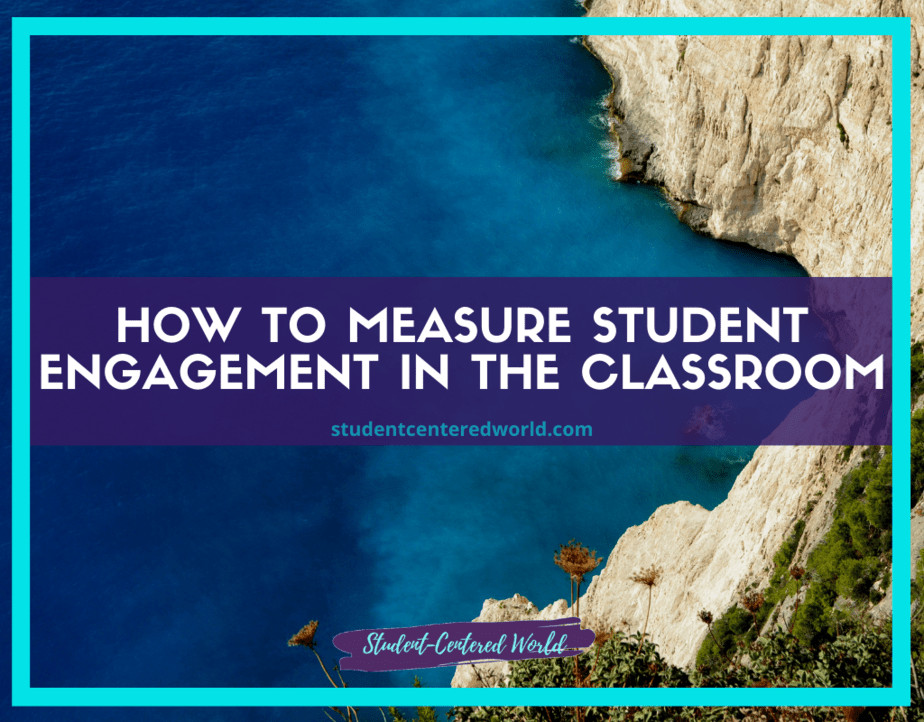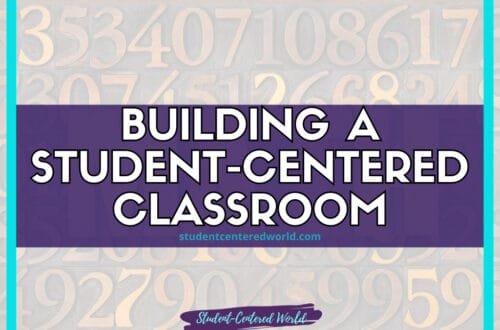9 Easy Engagement Strategies You Can Use Tomorrow
Click above to listen to this podcast episode. Below is the transcript for Student-Centered World Podcast Episode 54: “9 Simple Engagement Strategies You Can Use Tomorrow“
When it comes to simple engagement strategies, teachers often get nervous. There is a common misconception that in order to have all students engaged, it is way more work on the teacher. I am here to tell you that not only is that not the case, but once these student engagement strategies are routine, they almost run themselves.
Engagement Strategies #1: Provide an incentive or reward to keep students engaged
Plan some awesome outing or group activity for when you have hit a number of days without any of them falling asleep, everyone turning in their assignment by the deadline, or whatever goal it might be. Make it worth their while and let them know how they can earn points toward it.
You could even make it a competition between classes or groups within the class. This is something that should be worked on with your whole class and not just some individual.
If you separate your class into groups within the classroom this makes it very easy for them to see how well they are doing as well, which is great for getting some competition going between the groups.
It’s also worth letting the parents know about how they can help too!
Engagement Strategies #2: Conduct an anonymous survey of your students on how much they enjoy coming to school, retained from class that day, etc.
Here is how the survey should look. The first question should be how much they like coming to class each day. Then you need two questions, one for how much they liked how the class went that day and how much time they think was wasted during this time. This can help you figure out how important it is to plan in ways to keep students engaged throughout the day.
If you have the ability, use a clicker system like Socrative or a mobile app to see how students are feeling about how engaged they are in what is happening in class at that moment. The host (you) sees how they are answering, which helps you easily interpret the data. You can also easily ask how students feel about how engaged they are during the class taken right then at that moment.
Another tried and true method of student engagement strategies is by using Exit Tickets as a written anonymous survey or to assess how engaged your students were in a specific activity as they leave the classroom or transition into the next part of their day.

Engagement Strategies #3: Ask students how much they think their peers like school, class, etc.
Let them know how you are thinking of ways to improve how you go about things and how it would help if they could tell how well they thought things went that day and how important those topics were for them. This will give you an idea of how much they think about how you’re going and how you can make things better.
The best part of this angle, I’ve found, is that students are more apt to speak the truth since they’re talking about “somebody else”.
Again, let them know how it would help if they could give you feedback on how they feel about how things are going and how important or unimportant those topics were for them. In so doing, you are giving your students a voice to how they feel about how you run your classroom.
This is a win-win for everyone, especially if you are receptive to what they have to say and how much it will help them improve their way of learning and your student engagement strategies.
Engagement Strategies #4: Make sure you aren’t boring your students by asking them what parts of the lesson were boring and what can be done to make it more entertaining.
Entertaining doesn’t need to be a song and dance or hours of planning on your behalf. It can easily be just a simple shift in how you are giving out the exact same assignments or preparing for activities.
If students are bored, the class itself and the passing on of content knowledge will be less effective. Try to find ways to make the material more interesting by making the most of your time and incorporating multimedia materials or other elements that you think will improve interest.
Students who get agitated or look like they could fall asleep should be asked how they feel about the lesson and what can be done to make it more interesting. This will help you prevent falling into a routine of boring activities and push you out of your comfort zone as a teacher.
If you have a student who does poorly on an assignment or if they look uninterested in your class, it’s important to find out how they’re feeling about the material and how things are going overall. Maybe there is something specific that isn’t working for them and once you address it, their attitude will improve. Remember that everyone learns differently and what works for one student, may not work for another.
Maybe there are times when the material itself no longer interests students or they feel like they already know how to do something that you’re trying to teach. As an educator, you have to adapt your style as well as how you present information, so make sure that your teaching methods match how your students want to learn.
Engagement Strategies #5: Make sure students feel like they have a say in what goes on in class (the best of the engagement strategies)
How engaged students are is as much a result of them feeling like they have a say in class activities as it is about the material you’re covering. Giving students a voice will lead to more enthusiasm after lectures, and it will also help ensure that there isn’t any unnecessary confusion. In addition, seeing how engaged your students are in the material and how involved they are as a whole is excellent feedback for you.
How can I do that?
Give students some kind of voice in how class activities will look like. For instance, have them vote on what movie you’ll watch at the end of each unit, or how you and the students will review for your next assessment. You can also try asking questions that evoke a response from the class, such as “who here doesn’t like french fries?”, just to get them talking and refocused as you move back into the curriculum.
“But I need to stay on schedule!” If you often use PowerPoints or other lecture-based teaching strategies as your main point of content delivery, you might have to work this one in during the lecture (or switch up your techniques, which I’ll get to in a bit).

Engagement Strategies #6: Give students a chance to develop relationships with one another
How can I do that? – Invite students to form small groups, and let the groups work with each other on class activities. If you’re going to have students work together in groups, take the time during class to see how engaged they are with one another while they’re working, and then try to go over at least some of their errors and also focus on their strengths. It’s much more useful for you as a teacher if your students learn from each other how to interact and form those bonds with one another.
Now, not every student in the class is going to be best friends, but this is a great starting point in helping them learn how to work with and collaborate with others who may be different from them or someone that they wouldn’t necessarily have a personal relationship with outside of the classroom. These are skills that everyone needs as they get older and move into the real world, and the sooner we can encourage this the right way, the better.
Engagement Strategies #7: Focus on the effectiveness of the ways students are engaging with the material
Your efforts to improve student engagement and motivation will go a long way toward ensuring that it is actually teaching them something. Make sure they are engaged in the new lessons as you teach them, and monitor their progress to make sure they aren’t just paying attention to how much they are retaining.
Be sure that how engaged your students are at each stage is indicative of how they’ve learned the new material. This will give you more insight into how effectively your teaching methods fit the needs of your class.
How you know how they’re learning is something you have to figure out on your own. If you want a good way of observing how your class learns, try using how often certain questions are asked when there isn’t a teacher around for them to ask. This will give you an idea of how effectively you’re teaching them how to do things.
Take note of how much interest your class has in the topic at hand. This is especially helpful for those with short attention spans, as they are more likely to be engaged if there’s something for them to be excited about.
Engagement Strategies #8: Keep students interested in what you’re covering by providing ample opportunity for them to ask questions and be involved with group activities
If you can keep it fun, interesting, and interactive, your students will be engaged at all times. Try to find ways of how you can make your lessons interesting and fun so that students will be engaged no matter what you are covering.
Because how can you expect them to engage in the lesson if they are not enjoying it?
My thoughts: I can’t speak for all classes, but in my classroom, I kept them interested by making sure that we have fun experiments and simulations going on throughout the year. Personally, I find that the experiments we do are not only interesting and fun, but it helps them to remember how each of these things relates to real life.
I would suggest maybe coming up with some fun experiments and simulations throughout the year, bringing in a few trivial props, and just keeping it interesting. If you don’t tell them what to expect, maybe they won’t be so jaded and use this as an opportunity to actually learn something.
I’m sure that if your students know that the topic will be interesting to them, they’ll really be willing to engage in it!

Engagement Strategies #9: Teach in a way students can relate to or connect with
Whether relating to material directly with their own lives or by making the subject seem more personal through connecting your own personal stories, it is easier to teach interesting material. If you find a way to make the subject more fun and exciting for students and in ways they can relate to, you will be on your way to creating an effective learning environment.
There is no one way to engage students. Keep in mind that each student learns differently and how you teach can affect how they learn or if they learn at all. If some students are more visual learners, then use an activity where they get up and move around rather than seating them for a lecture.
If others are more hands-on, use activities that require them to do something instead of just reading. Use your students to learn how they like to work and how they respond best.
Many times, students become disengaged because they see how what you’re teaching is not directly related to how they want to live their lives. If you can relate how the subject is directly related to what they’re interested in or how it will be used later on down the road, then you engage students more.
A friend of mine once told me how he uses his iPhone to help teach his curriculum. He explains to the students how to use apps or how to update contacts or how to add a wallpaper. Things the students will be able to relate how they’re learning with how technology is used in their everyday lives, which was what his curriculum was centered upon.
Make it personal! You can do this by sharing your life experiences and how you were able to solve a problem because of what you learned (or retained). The more “real” and interactive you can make it (and can avoid the ever frustrating, “When are we ever going to use this in real life?”), the better.
Stop Driving the Teacher Struggle Bus
Are you struggling with student engagement, apathy, or keeping your class on track?
💫💫 There’s hope! 💫💫
Join my free teacher workshop “Choosing Choice” and in just 60 minutes, you’ll craft a practical plan to revitalize your teaching. Discover the magic of student choice in boosting engagement, gain quick implementation ideas, and explore strategies for year-long success.
Unlike overwhelming workshops, my approach guides you in real-time, providing more classroom options, reducing stress, and giving you more personal time.
Plus, you’ll earn a 1-hour professional development certificate and have 7 days of access.
Don’t miss this chance to transform your teaching; click below to secure your spot now!






